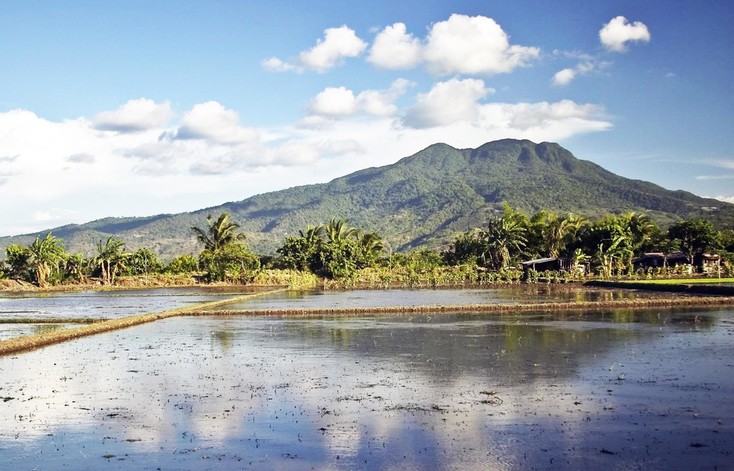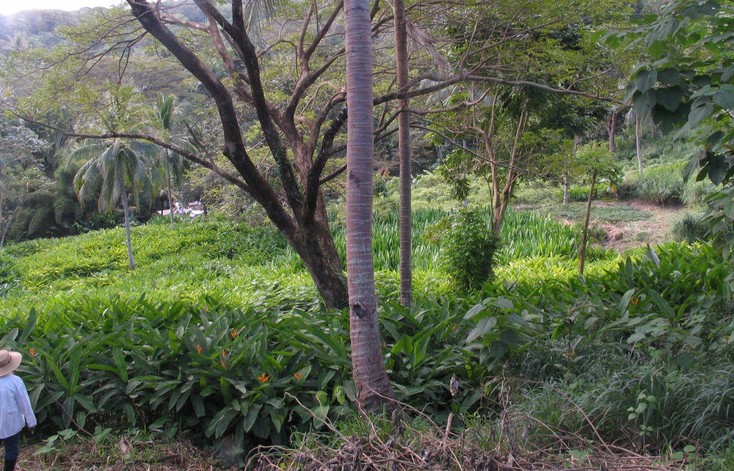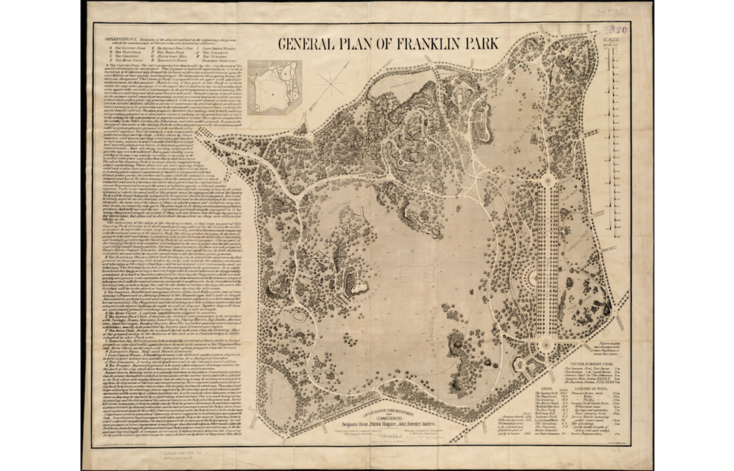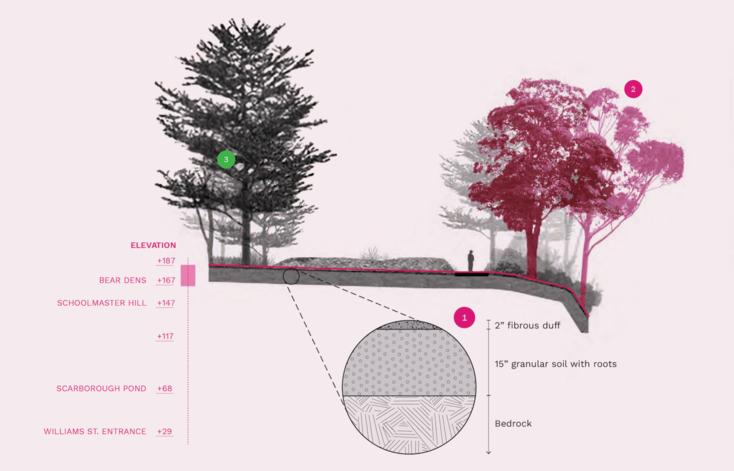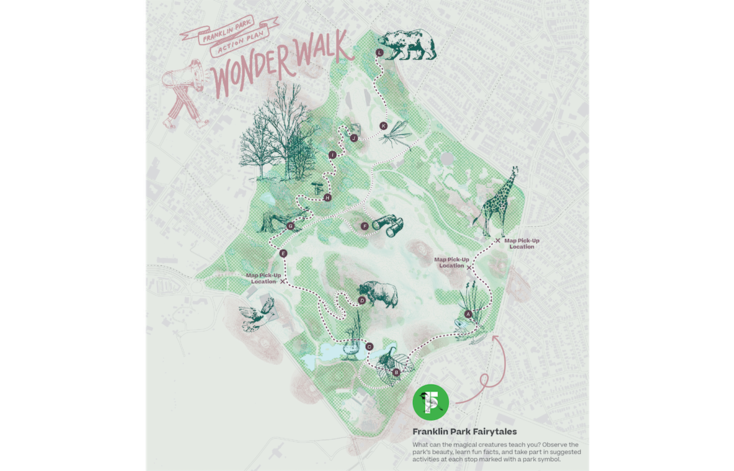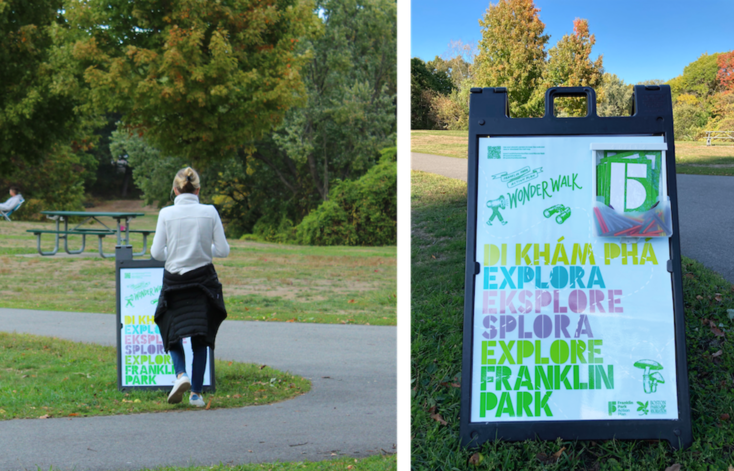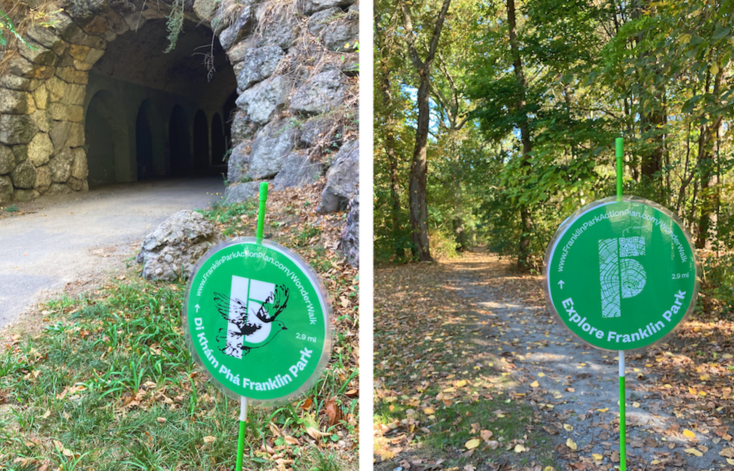Here Be Dragons
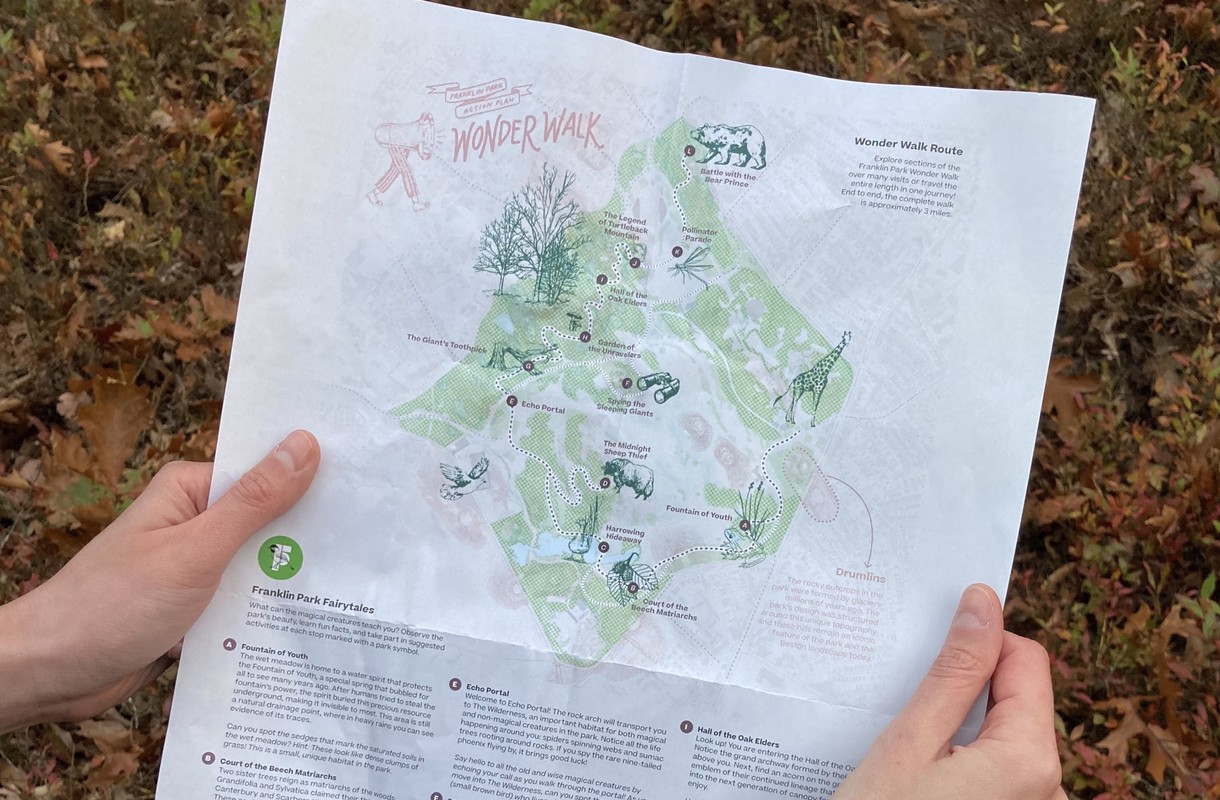
Danica Liongson on the landscapes that we carry with us into practice, as illustrated by the story of the 2020 Wonder Walk for the Franklin Park Action Plan.
The double vision started with a Komodo dragon (1). My lola (Filipino for ‘grandmother’) was confident that one roamed the mountain where she lived in the Philippines. When my family visited her during winter holidays and summer breaks, she enlisted my brothers and me to help her catch it.
Bound by duty and armed with imagination, we tiptoed along the ridgeline of Mount Makiling and swept the valley through binoculars. Fallen fruit on the tropical forest floor was a lizard lunch finished minutes before we arrived on the scene. A dangling vine was an escape route; a tuft of ferns, a soft place for a nap. Everywhere we looked, the familiar hills and valleys were recast as an amusement park for a giant, secretive, fantastical creature (2).
The elusive forest monster’s fate hinged on who could successfully ensnare it. My lola planned to make it the mascot of a Jurassic Park-themed egg hunt for Easter with the whole town invited to participate. One of my brothers was scheming to screenprint its likeness on t-shirts and sell them to his friends. My other brother intended to study it more closely and then release it back into the wild. As for me—it was not about capturing the dragon, but perfecting the pursuit. I wanted the quest of reading the landscape to never end.
My path to landscape architecture was a wandering one. A curiosity and reverence for the natural world led me to believe that I should become an environmental lawyer or a city planner. But when I tried on both for size, neither fit. I did not know the name of the profession, but I had my heart set on creating memorable spaces that would make people notice and remember, much like my lola had made the hills and hollows of her home come alive for me. The answer revealed itself through a slide projector radiating a giant plan of Boston’s Franklin Park by Frederick Law Olmsted in a college lecture hall. As I gazed upon the larger-than-life drawing, I realized: landscape architects design places.
With lizard trap patents and walking sticks laid down for the pen, my discoveries and aspirations now live inside plan drawings and diagrams. Attunement to the nuances of the world around me is the first step in my craft (3). I want to show others how to see the world like a landscape architect. On-site subtleties translate into layers of lines and brush strokes, bounding arrows and scrawling annotations. Drawings and words work together to capture the ephemeral and render it immortal. The color of light that only shines at a certain time of day, the whisper of a breeze slipping through leaves, the slightest incline to the ground—all of this and more are phenomena I consider essential to getting to know a place.
As I embarked on my first projects at Reed Hilderbrand, I found myself once again pouring over a map of Franklin Park. The jewel of the Emerald Necklace that I had learned about as a student was now my site. I had the opportunity to participate in envisioning its role for the next fifty years. Alongside Agency Landscape+Planning, MASS Design Group, and a large, interdisciplinary consultant team, the prospect of building onto its enormous legacy was, and still is, humbling.
So began the synthesis of historical timelines, demographic data, and scientific facts into digestible drawings and diagrams, for the site inventory and analysis stages of the project. The design team poured over memos and reports from expert consultants for numbers, percentages, and technical names. Then we used those findings to inform illustrative sections and color-coded maps to communicate the information visually. The result was a robust analysis report.
Simultaneously, the design team facilitated engagement with the park’s neighbors and visitors through surveys, workshops, and pop-up events. It was evident from the start that Franklin Park is deeply cherished. There is the importance of the land the park sits on to the Massachusett tribe, the meaning it has for the park’s neighbors who grew up visiting the park every weekend, and the pivotal role the space offers the community for large gatherings that celebrate culture or express political stances. Local stewards ensure that it continues to be beloved and useful as a shared resource.
The engagement process started with in-person events, but the COVID-19 pandemic suddenly limited social interactions in the months following the project launch. Staying connected took on a different form as we went from rooms buzzing with overlapping discussions to physical separation and appearing as tiny squares on a screen. Spending time outdoors at a safe distance from others became especially important for those visiting the park. The design team learned the community enjoyed particular walking routes and had an interest in more ‘nature walks’ and insights into the park’s environment. Building on this, the design team proposed a self-guided nature walk as a way to invite the community to stay engaged with the Action Plan process during a period of isolation for public health.
As the idea for the self-guided nature walk was forming, we discovered “The Dorchester Giant” by Oliver Wendell Holmes (4). The 1830 poem speculates on the origin of puddingstone, the lumpy, composite geology found throughout Franklin Park:
What are those lone [giant] ones doing now,
The wife and the children sad?
Oh, they are in a terrible rout,
Screaming, and throwing their pudding about,
Acting as they were mad.
They flung it over to Roxbury hills,
They flung it over the plain,
And all over Milton and Dorchester too
Great lumps of pudding the giants threw;
They tumbled as thick as rain.
The whimsy of this poem crystallizes how I feel when I spend time at the park—it does not seem far-fetched that a giant could live there—and the sense of wonder that I try to share with others. Picture this: expansive views from lofty ridges, peering out from the trees. Then follow paths winding through a blanket of leaves, over purple rocks, and down to the dappled light at the bottom of dales. Glance up and notice the rhythm of the canopy and open sky alternating overhead. Imagine the quiet stillness of the place under snowfall and the sudden beauty of spring buds breaking free from their drab jackets. From the languid summer through the fiery fall, look for the people gathering in the open fields, and join them in coming together in an oasis from the city.
When the winds of autumn blow through Boston, they bring with them a fairy dust that enchants the world around us. Franklin Park has been transformed into a playground for magical creatures. From when the leaves begin to change color until the first frost, park visitors can see traces of magic as small as a dew drop to as large as a giant’s footprint. Can you find the clues they leave behind in Franklin Park?
A sense of magic grew around the self-guided nature walk, which we dubbed: “The Wonder Walk.” The route followed a three-mile itinerary through Franklin Park, inviting people to meander with a mind open to the extraordinary. We set up sandwich boards with physical map printouts at key locations in tandem with the release of an app, developed with wayfinding consultant OverUnder, that included Spanish translations. At set intervals, signs prompted people to pause and observe their surroundings through the lens of enchantment. On the Wonder Walk, two magnificent beech trees became sylvan sisters holding court in the forest. A purple puddingstone boulder was hiding a werewolf, waiting for sheep in the meadow to come home. The fallen log in the clearing was colossal to us passers-by, but a mere toothpick for a camouflaged giant. At each stop, visitors were prompted to read a “Franklin Park fairytale” and also learn something meaningful from the Action Plan analysis report: a description of ecological processes, the geological formation of the hills and valleys, or an insight into that particular spot in the park’s past. Through the app, visitors could also give feedback at each stop, whether to ask questions for the design team or share stories of their own. Our way of engagement invited people—both the young and the young at heart—to explore the park for the first time or, for those who already knew the park well, to see it in a new way.
The casting of a giant in Holmes’ landscape creation myth reminded me of a local folktale about the mountain where my lola lives. Mount Makiling is said to be the home of the goddess Maria; the ridgeline is the profile of her laying down to rest. She is the guardian spirit of the mountain and forest, a steward caring for all the plants and animals, especially after storms and typhoons. My lola told us that if we ever became lost, Maria Makiling would offer the fruits of the tropical forest so we would not go hungry until we were discovered or found a way home. But, she warned, if we tried to take more than we could eat or did so with avaricious intentions, Maria would punish us and we would stay lost forever. This story was about providing comfort and reassurance, as well as discouraging greed within our relationship to the natural environment. The story format imparted a lesson, while capturing the imagination at the same time.
The bedtime stories that my Komodo-dragon-hunting lola told did not feature charming woodland creatures; she imparted fables with moral lessons that were acted out by characters like justice-serving goddesses, bloodthirsty man-sized bats, and conniving mosquitoes with hidden agendas (5). So while we wove together characters and lessons for the Wonder Walk, it was crucial to not only include the conventional markers of a fairytale—princes and knights, giants and fairies—but also the characters of the folklore of my childhood and other cultures. Knowing that people likely grew up with an eclectic mix of stories with characters as unique as their settings, I set out to read fairytales representative of the different cultures in the surrounding area of Franklin Park. I learned about the good fortune bestowed on those who chance upon a nine-tailed phoenix in Chinese mythology and the African fable about misplaced trust and subsequent betrayal with the midnight goat thief. Over and over, I saw matriarchs instead of monarchs, respect for ancestors, and lessons of living in harmony with the natural world. The Wonder Walk could set a place for elders, duendes (elves), and water nymphs to live too. I wanted the characters to be familiar, so I borrowed from my background—one filled with storytelling—and blended it with the work of connecting people with the landscape.
The park’s spatial form helped shape the “fairytales,” but sometimes the source of inspiration was less about the physical features and more about the evocation of certain feelings and associations. Joan Mitchell, the renowned abstract painter, writes: “I paint from remembered landscapes that I carry with me” (6). As I encounter places that are new to me, I also carry with me all the landscapes and stories I’ve known before. In my practice of landscape architecture, familiarizing myself with an unfamiliar place is also an act of transforming it through memory, to experience it as a product of both my past and present.
I will always carry the mountains of the Philippines with me, and now there is another landscape forever beside it. Franklin Park has become one of those places that I will continue to contemplate and revisit throughout different times in my life. The landscape of my childhood and the landscape of my initial professional practice are both significant to me, yet bear different weights and hold distinct meanings. Mount Makiling revealed the delicate balance of give and take between humans and the natural world, while Franklin Park showed me that a place always has more than one story to tell. These observations are not immutable; my perceptions will inevitably change as new insights are kindled through the landscapes I have yet to encounter. But these experiences will stay with me as I grow and evolve as a person and as a designer. When I think of Mount Makiling and Franklin Park, both landscapes fill me with topophilia, a love of place (7). To love a place is to see it as it is, but also as it could be.
My lola was the first person to show me topophilia, the sight of double vision. She reveled in the bountiful fruit trees, mysterious creatures, and flowing waters of Mount Makiling. Yet she also respected the larger forces of typhoon winds and rains that could take it all away in a single storm. Folklore had taught her that the natural world is cyclical, and the landscape is home to all types of life: plant, animal, human, and supernatural. To ensure what is abundant could weather periods of scarcity for everyone’s benefit, it was imperative to be a good steward. My lola embodied Maria Makiling, safeguarding the mountain and passing down stories so others could step into the role of caring for the place, too. Like landscape architecture, storytelling is its own form of stewardship.
In my practice, reading the landscape is topophilia in action. It is a lens through which to perceive the palimpsest that is the ordinary, the significant, and the in-between. Drawing the mental map of the landscapes I carry, I am reminded of the tale of cartographers long-ago who marked unexplored areas of a territory with the note: “Here be dragons” (8). What was written as a warning to stay away, to me, extends an invitation. To continue being a landscape architect engaging her craft, a part of me will always be looking for dragons.
Endnotes
(1). My family folklore refers to the forest creature as a “Komodo dragon,” but the actual creature is more accurately classified as the monitor lizard.
(2). Evidence of the Komodo-dragon-cum-monitor-lizard in the Philippines can be found here.
(3). In doing so, I remember the words of Mary Oliver—a poet, for whom nature was a source of constant inspiration—who declared, “Attention is the beginning of devotion.”
(4). Holmes, Oliver Wendell. “The Dorchester Giant.” Poems of Places: An Anthology in 31 Volumes, ed. by Henry Wadsworth Longfellow. Boston: James R. Osgood & Co., 1876–79; Bartleby.com, 2011.
(5). A personal favorite was one which explained: Why Mosquitoes Hum and Try to Get into the Holes of our Ears.
(6). The full quote: “My paintings are titled after they are finished. I paint from remembered landscapes that I carry with me—and remembered feelings of them, which of course become transformed. I could certainly never mirror nature. I would like more to paint what it leaves me with.” Letter from Mitchell, in John I. H. Baur, Nature in Abstraction: The Relation of Abstract Painting and Sculpture to Nature in Twentieth-Century American Art (New York: Whitney Museum of American Art, 1958), p. 75.)
(7). This attachment to a place is a topic of deep study for Yi-Fu Tuan, a key figure in the field of human geography who examines the relationship between people and space. In his book Topophilia (1983), Tuan describes the environment as “not just a resource base to be used or natural forces to adapt to, but also [a source] of assurance and pleasure, objects of profound attachment and love.” In a world where worth is measured by productivity or usefulness, Tuan recognizes valuing a place for its mere existence.
(8). The expression “here be dragons” has its own storied past. While graphic depictions of mythical creatures emphasized the unknown in cartography, the written phrase itself has only been found on a globe rather than on a map. See this article for more information.
Published
February 2022
